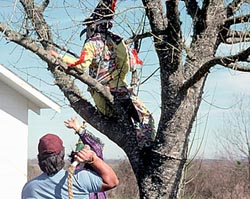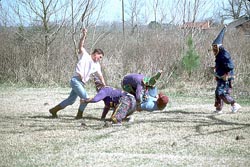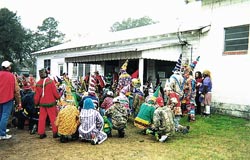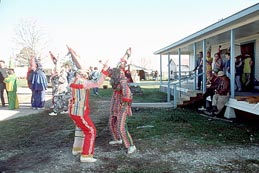Cajun Women and the Country Mardi Gras Tradition
By Carolyn E. Ware
Cajuns and Creoles on French Louisiana's rural prairies traditionally celebrate the last day before Lent by "running" Mardi Gras. Early on Mardi Gras morning—or in some cases on the Saturday or Sunday before—bands of disguised riders on horses or trailers set out to scour the countryside. Stopping at homes along the way, they sing, dance, clown, and coax hosts into donating "a little fat chicken," sausage links, onions, rice, or lard. Unmasked capitaines make sure the rowdy beggars (known as les Mardi Gras) behave themselves, reassuring homeowners that—despite all appearances—the mischievous visitors are not dangerous strangers, thieves, or troublemakers. In reality, their mission is to collect ingredients for a gros (big) gumbo, a meal they share with the community later that evening.
The country courir de Mardi Gras, or Mardi Gras run, belongs to an ancient tradition of masked begging processions—sometimes called midwinter "luck visits"—once widespread in Europe. As these customs spread to Nova Scotia, Newfoundland, the Caribbean, and parts of the United States, they remained dynamic by adapting to new surroundings and changing times. By the middle of the 20th century, many Cajuns in French Louisiana had lost interest in running Mardi Gras (and Cajun culture in general) in a shift toward Americanization. The last two decades or so, though, have seen a revitalization of the country Mardi Gras celebration. Each year, more than a dozen rural Cajun communities, and several Creole communities, hold Mardi Gras runs that include anywhere from fifteen to hundreds of riders.

Past observers often remarked that Cajun Mardi Gras runs were overwhelmingly male. Popular author Harnett Kane, in his 1943 book The Bayous of Louisiana, wrote that the country Mardi Gras run is "primarily for men and horses." Its begging, singing, and riotous horseplay, he commented, "has no place for the girls . . . although there is a happy fais-do-do [dance] in the evening."
Then as now, women did in fact play essential roles in the celebration, but their work was mainly behind the scenes. In the days and weeks before Mardi Gras, wives and mothers designed, cut, and sewed their menfolks' fringed Mardi Gras suits—though for poor families during the Depression, a suit might consist of a few colorful patches sewed onto work clothes. Women spent Mardi Gras cleaning hens and chickens, cooking gallons of gumbo and pots of rice, and serving the hungry maskers at the end of their run. Plucking dozens of chickens was hard and dirty work, but women entertained themselves by joking and gossiping among themselves, perhaps taking a nip of whiskey, and playing practical jokes on the men when they returned. Young girls and married women alike ended the day by dancing at the Mardi Gras bal—the "happy fais do-do" described by Kane.
Many women enjoyed their support roles and accepted the fact that only men ran Mardi Gras. As Agnes Miller observed of her youth in Basile, "It wasn't a custom that we [girls] did run." Nevertheless, women often felt deeply invested in their community Mardi Gras tradition, and took pride in passing it along to their children and grandchildren. Eventually, though—maybe inevitably—some women decided that they too wanted to mask and run Mardi Gras. As one woman put it, "We wanted in on the fun, not just the work all the time."
However, the idea of men and women running Mardi Gras together was almost unthinkable in the 1940s, 1950s, and even the 1960s. As the late Vories Moreau explained to folklorist Carl Lindahl, "It wouldn't have been considered very nice for the men and women to run together." Not surprisingly, women who tried to join all-male runs during this period had little luck. Captains and male riders explained that they wanted to keep the tradition just as it was, as well as to protect women from the event's rowdiness. Nor did women necessarily embrace the idea of mixed runs. A short-lived attempt to include women in the Mamou run during the early 1950s ended when wives protested that they wouldn't let their husbands take part alongside women.
Still, women determined to run Mardi Gras at mid-century had several options. One was to form small family runs in which men, women, and children masked together. Another was to found their own "ladies' runs," usually held on the weekend before Mardi Gras. The decades after World War II saw a spate of ladies' runs in small towns and rural neighborhoods. Between 1945 and 1975, women's Mardi Gras runs began in Pointe Noir, Eunice—which supported two separate women's runs for a while, Duralde, Basile, and Tee Mamou. (Tee Mamou, or Little Mamou, is a stretch of Acadia Parish countryside not to be confused with the town of Mamou.) In all likelihood, there were others as well.

Typically, the founders of these pioneering runs were hardworking farm wives, already mothers and even grandmothers. (Young girls were closely protected and supervised before marriage, and few parents would consider letting them run Mardi Gras.) For Cajun countrywomen, running Mardi Gras provided a chance to let loose for a day—to dance and perhaps flirt a little with men not their husbands, make outrageous jokes, drink a little whiskey, and generally act "crazy" with close women friends. Frozine Thobodeau, who ran Mardi Gras in Pointe Noire during the 1940s and 1950s, told folklorist Donna Onebane that as the women traveled,
We'd make noise like little kids. We was enjoying ourselves. Each was telling a story about where we could find some pretty men, what we would do when we got to the [dance] hall, and we was planning everything, you see." When the women begged onlookers for coins, according to Mrs. Thibodeaux, their victims "didn't have no chance. Might as well just leave the money right there.
Interestingly, most women's runs had (and still have) male capitaines. Women, it seems, were reluctant to trade the fun of "cutting up" for the responsibilities of leading the run; instead, they recruited husbands, sons, or male neighbors as captains. Most ladies' runs traveled on farm wagons or trucks rather than horseback—a practical adaptation that is now common among many Cajun Mardi Gras runs. Virtually all of these women's courirs served as important bridges for community Mardi Gras traditions, helping to keep the custom alive during a period when few men were interested in taking part.
In time most of these early ladies' runs disappeared, but women now have more Mardi Gras options than ever before. Once—separate women's courirs in Eunice and Basile merged with and reinvigorated local men's runs in the 1970s and 1980s. Today, mixed-sex runs also take place in at least five other Cajun communities. In Basile, women not only run Mardi Gras but serve as capitaines, along with several male captains. Tee Mamou, on the other hand, has maintained both its women's run (on Saturday) and its men's run (on Tuesday), and both are thriving. In addition, a growing number of children's Mardi Gras runs offer young girls a chance to learn the art of running Mardi Gras at an early age. Thanks in part to women's participation, community Mardi Gras runs have grown considerably in number, size, and popularity.
Women have subtly refashioned the Cajun Mardi Gras tradition over the years, developing their own styles of clowning, begging, and disguise. Some women, for example, have developed a "clever" or "witty" style of clowning in contrast to men's more macho and physical horseplay. (Other women, though, are a match for any male Mardi Gras in their roughhousing. Merline Bergeaux and Shirley Reed of Tee Mamou say proudly, "We're the chicken chasers . . . [always] in the mud and the barbed wire." ) Often, women's Mardi Gras performances are more collaborative than men's, as they boost each other into trees, or surround and tackle a young capitaine.
Women's Mardi Gras influence is most evident in the disguises they create and wear. Today, as in the past, women make almost all of the multi-colored Mardi Gras suits and the tall, pointed hats called capuchons. Today, though, they are likely to be creating suits and hats for themselves, as well as for male relatives. Suits often combine bright solid colors with loud prints, capuchons are covered with matching fabric, and both are circled with fringe. Prints with crawfish, chickens, hot peppers, or other Louisiana icons are especially popular, but women also make suits from hunters' camouflage material, shiny lamé or satin (especially in Basile), and other materials.
One notable change is that today many Cajun women also turn their imaginations and skills to crafting masks, once a mainly male art. Many women make the wire screen masks that many Cajuns consider most traditional, but they also also experiment with new materials, tools, and techniques. Lou Trahan of Egan uses hosiery stuffed with cotton to create absurdly long noses and fat lips for her masks, a trick she remembers seeing when she was a girl. Hattie Freeman of Eunice makes masks out of plastic milk jugs, leaving the handle as a nose. Female mask makers in some communities also decorate their masks by recycling everyday objects—feather dusters, shoulder pads, tire treads, and costume jewelry—in funny and imaginative ways.
Many women who make masks, like men, make one or two a year at the most. A growing number of women, though, create masks on a much larger scale. Tee Mamou, where hand-made masks are required, has an especially talented and prolific group of women mask makers. Suson Launey, Renée Frugé Douget, and Jackie Miller all make (or have made) dozens, even hundreds of one-of-a-kind masks each year. They demonstrate their art at folklife festivals, workshops, and other public programs, and their creations are sought after by tourists, art collectors, and museums, as well as by other Mardi Gras. (Renée, newly married and working full time, has less time to make masks these days than in the past.) For many people, these women and their masks have come to publicly represent the country Cajun Mardi Gras tradition.
Suson Launey, one of Tee Mamou's pre-eminent mask makers, began making her own masks and suits when she joined the Tee Mamou run 23 years ago. Like many women, Suson found that wire screen masks gouged her face as she ran, climbed trees, and tangled with male captains. She explains, "Our group is rough. To run with a screen mask, my face would look like hamburger—it gets all scratched up." Her inspired solution was to stitch yarn masks onto flexible plastic screen. Soon other revelers asked her to make masks for them, and several women—and at least one man—started making their own versions. Needlepoint masks have become a hallmark of the Tee Mamou women's run, and are seen in smaller numbers in the local men's run.
Suson makes hundreds of masks, both screen and needlepoint, each year for fellow Mardi Gras, collectors, and visitors to festivals such as the Louisiana Folklife Festival and the New Orleans Jazz and Heritage festival. Often she personalizes masks for friends by incorporating private jokes or references. For instance, she says, "I made one for a friend of mine, his nickname is Frog, so I made it green and it looked like a frog." One of her most memorable masks had "a big old mouth with a tongue sticking out," she says. "That's me, you know, a big mouth. If you make it personal, you pick something that works and go with that."
Cajun women who run Mardi Gras or make masks see themselves as continuing a prized community tradition, not changing it. Berline Boone, who has run Mardi Gras in the Basile area for more than 30 years, sums up her love of Mardi Gras:
I'm 58 years old and I've been running Mardi Gras more than half my life and I still love it just like when I was [a] little girl. And as long as the good Lord allows me to run Mardi Gras, I will keep running. The age doesn't mean anything to me, it's what's in our hearts that counts.
References
Kane, Harnett T. 1943. The Bayous of Louisiana. New York: William Morrow and Company.
Onebane, Donna Magee. 1999. "The Voices of Pointe Noire: A Study of Place and Identity." Unpublished dissertation, University of Louisiana at Lafayette.
Ware, Carolyn. 1995. "I Read the Rules Backward: Women, Symbolic Inversion, and the Cajun Mardi Gras Run." Southern Folklore 52 (2): 137-160.
_____. 2001. "Anything to Act Crazy: Cajun Women and Mardi Gras Disguise." Journal of American Folklore 114(452):225-247.




